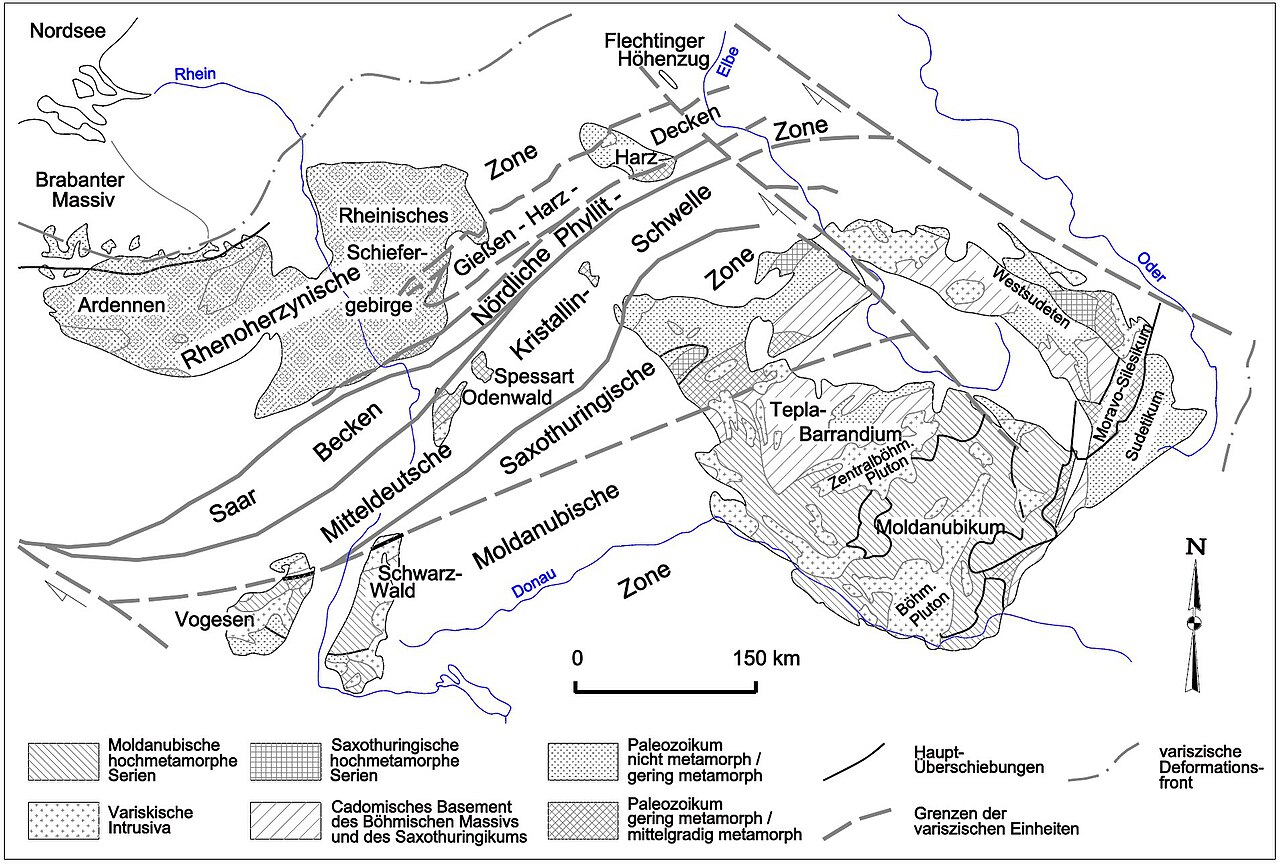Bohemian Massif
As Bohemian Massif Bohemian Massif or ( Czech Český masiv or Česká vysočina " Bohemian highlands " ) is called the geologically old hull Mountains in the Czech Republic and in the border region of Lower and Upper Austria and Bavaria. It is as strongly eroded remnant of an ancient mountain range from the Paleozoic a characteristic element of the geology of Central Europe and of the European Central Upland Range.
- 2.1 Geological Outline
- 2.2 rocks
- 3.1 The Bohemian Massif and the Alps
Geography
Surface shape
The Bohemian Massif is mostly flatter landscapes. The hull area ( north of the Danube ) is characterized by gentle depressions and valleys as well as long-span, low back and buttes. From the acidic bedrock mainly brown soils have developed in depressions and flat surfaces also influenced by groundwater gley soils.
As in other mountains of the European Central Upland Range, the Talstrukturen are irregular and less well organized than in the comparatively young ceiling and fold mountains of the Alps. Orographic uniform, however, are the plateaus. The breakthrough valleys belonging to this geological region, the Wachau, the Strudengau and the Danube valley of Vilshofen via Passau and the Danube loop to Aschach
Geographical breakdown
The Bohemian Massif is divided into the following units:
- Bohemian Forest
- Upper Palatinate Forest
- Bavarian Forest
- Novohradské Bergland
- Austrian gneiss and granite highlands, high and deep ridged hull surfaces of the Austrian mill and forest district with the Weinberger forest and other areas
- Bohemian-Moravian Highlands between Ceske Budejovice and Brno
Smaller strips can also be found on the southeastern edge of the Vienna Basin and south of the Danube:
- Dunkelsteinerwald and Hiesberg the Wachau
- Neustadtler plate of Strudengau
- Kürnberger forest near Linz
- Sauwald between Eferding and Passau
Geology
Geological outline
The Bohemian Massif, together with the Black Forest and the Vosges Mountains, the central region of the central European Variscan Mountains.
The Czech Stratigraphic Commission has fixed by decisions of 1992 and 1994, the following six regional geological units of the Bohemian Massif:
- Moldanubische zone
- Kutna Hora - Svratecká zone
- Bohemikum ( Central Bohemia region )
- Saxon-Thuringian zone ( südöstl. part of Saxothuringian )
- Westsudetische zone
- Moravosilesikum ( Moravian- Silesian zone)
Rocks
The Bohemian Massif is composed of crystalline rocks, mainly from granites and gneisses. The former plutonic rocks and rocks conversion store on the south and west, but continue in the northern border of Bohemia. The metamorphic rocks of gneiss and crystalline schists are largely in the inner ring, and in Moravia and Lower Austria.
Geological disturbances
From the southern edge of the Bohemian Massif draw several fault zones to the northeast; These are about the Rodl, Vitiser and the Diendorfer disorder that can be seen even on the satellite image. Diagonal to extend the Danube disorder Pregarten disorder and the Klam disorder.
The Bohemian Massif and the Alps
The Bohemian Massif was during the Paleo-, Meso - and Cenozoic in tropical and subtropical areas. Only in the younger Tertiary turned the Eurasian plate to the north.
The Bohemian Massif was abutment of alpidic orogeny. It is also known as the crystalline basement, because it came to rest over wide areas under the younger formations of the Eastern Alps and the Molasse of the Alpine foothills. This is partly to tectonic thrusts of more than 100 kilometers, driven by the African plate and its northern drift. This solved before about 30 million years ago from the Alpidic orogeny and long-range movements.
Among the northern Alps are the rocks of the Bohemian Massif as long, gently deformed strip. When Traunstein - about 60 kilometers south of the Danube in Linz, almost 100 kilometers away from today's hull Mountain - is this crystallin in 7 to 10 miles deep. The density anomalies account for only a few percent, but can be detected despite these depths in the local gravity field.
Mineral resources
Unlike resin, Ural and other Variscan mountain ranges are found in the Bohemian Massif hardly deposits of ores. In contrast, granites, granodiorites and diorites few are accessible in many quarries. Kaolin is, for example, mined in mountain sword.










